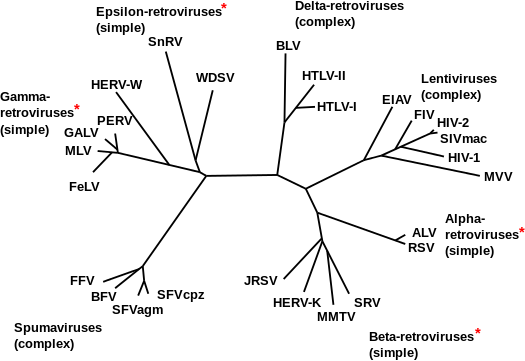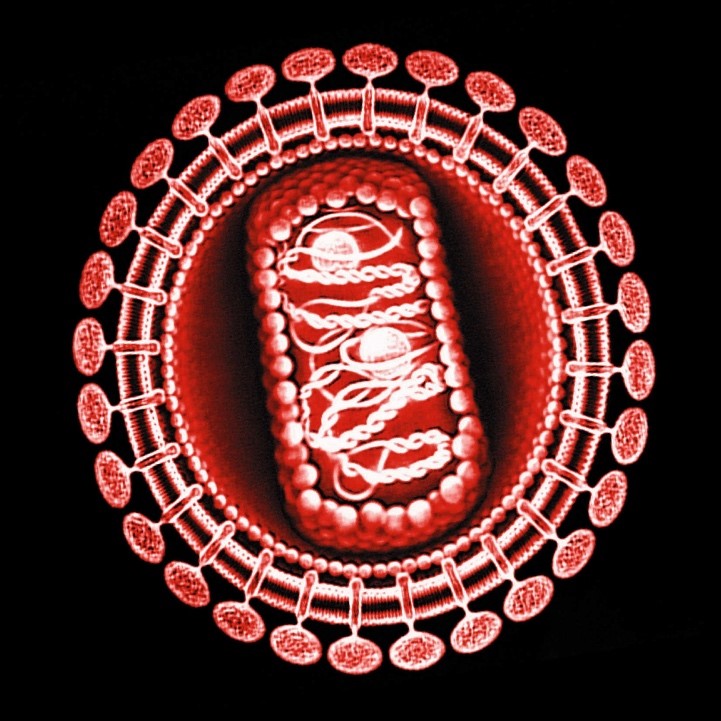
Retroviruses, such as human immunodeficiency virus (HIV), Simian immunodeficiency virus (SIV) and human T-lymphotropic virus (HTLV), are RNA viruses that reverse-transcribe their RNA into proviral DNA. Virions of retroviruses are composed of enveloped particles about 100 nm in diameter. The virions also contain two identical single-stranded RNA molecules 7-10 kilobases in length. Retroviruses have a membrane containing glycoproteins, which can bind to a receptor protein on a host cell. These viruses are associated with a wide variety of cancers in human, chicken, mouse, monkey, and so on. Some retroviruses cause a specific type of cancer soon after infection in a high proportion of animals, whereas others cause various cancers late after infection in a lower proportion of animals. Highly oncogenic retroviruses are recombinants of viral and host genes. There are two types of retrovirus, exogenous retrovirus and endogenous retrovirus. Exogenous retroviruses are infectious viruses which are transmitted from individual to individual while endogenous retroviruses (ERVs) are endogenous viral elements in the genome that closely resemble. ERVs can be derived from retroviruses. Human endogenous retroviruses (HERVs) are retroviruses that infect human genome millions of years ago and have persisted throughout human evolution. About 8% of our genome is composed of HERVs. HERVs could potentially cause diseases, such as autoimmune disease or cancer, through several mechanisms.
HIV is a lentivirus, a subgroup of exogenous retrovirus, that attacks the immune system and then progresses to acquired immunodeficiency syndrome (AIDS). AIDS, a condition in humans who have progressive failure of the immune system, is the final and most serious stage of HIV disease. It causes severe damage to the immune system.

Most people who have infected with HIV may not have any symptoms. They may have a flu-like illness within a month or two months after exposure to the virus, with fever, headache, tiredness, and enlarged lymph nodes. After a week to a month, these symptoms usually disappear and are often mistaken for those of other viral infections. During this period, HIV is present in large quantities in blood, semen, and vaginal fluids and people are very infectious. More severe HIV symptoms (such as profound and unexplained fatigue, rapid weight loss, frequent fevers, or profuse night sweats) may not appear for 10 years, or within two years in children born with HIV infection.
HIV antibodies appear as long as six months after infection to be produced in quantities large enough to show up in standard blood tests. People with HIV infection can be diagnosed by testing blood for the presence of antibodies (disease-fighting proteins) to HIV. Researchers have developed drugs to fight both HIV infection and its associated infections and cancers. In combination with early detection, available HIV therapies can greatly extend life span and improve the quality of life, and have resulted in a dramatic decrease in AIDS deaths. Since there is no cure or vaccine to prevent HIV, the only way people can prevent infection from the virus is to avoid high-risk behaviors putting them at risk of infection, such as having unprotected sex or sharing needles. Everyone ages 13 to 64 should be tested for HIV as part of their routine health care. Catching HIV in its early stages can make a lifesaving difference.
HTLV, the first human retrovirus to be associated with malignant disease, is a retroviral infection that affects the T cells. Four distinct lineages of HTLV have been identified since the discovery of Type 1 in the early 1980s. HTLV-1 is known to cause malignant and neurological disease in humans, while HTLV-2 has been associated with unusual cases of HTLV-1 associated myelopathy/tropic spastic paraparesis (HAM/TSP)-like illness. Little is known about HTLV-3 and 4 and whether they cause disease in humans remains under discussion.
Symptoms include progressive muscle weakness in the legs, muscle stiffness and spasms, lower back pain and inability to control their bladder or bowels.
In addition to a complete physical examination, thorough neurological and ophthalmologic examinations should be performed in patients infected with HTLV. HTLV-1 infection is usually diagnosed using a blood test to detect antibodies to the virus. Initially, lower-cost screening tests such as enzymatic immunoassay or agglutination tests are used. The low specificity of these tests means they often give false-positive results. It is recommended that positive results be confirmed by indirect immunofluorescence or Western Blot. Because many people have no obvious symptoms, some will only learn that they are carrying the virus when blood is being tested for other reasons. Good oral care and routine dental follow-up are recommended. No treatment intervention exists for acute or chronic HTLV infection. All patients with HTLV-1 or HTLV-2 infection should be counseled extensively on the lifelong implications of their infection.
References: